JoAnn and I sing in local symphonic and opera choruses in the Silicon Valley area, most regularly with the Stanford Symphonic Chorus and West Bay Opera. We were very fortunate to be able to participate in the Stanford China Music Tour in June and July. The various choruses at Stanford contributed to the Stanford Choral Union, which toured together with the Stanford Symphony Orchestra, the Stanford Chamber Chorale, Stanford Taiko, the Los Angeles Children’s Chorus, the Silicon Valley Ai-Ye Chorus, the Taiwan University Alumni Chorus of Northern California, the St. Lawrence String Quartet, and featured soloist (and Stanford alum) Jon Nakamatsu.
Our part of the tour started in Shanghai. We had a pretty light schedule at first to get acclimated to China and recover from jet lag. JoAnn and I headed out to the Bund, where you can see the older colonial buildings on one side and the big new tours of Pudong on the other. Pudong really is something to see:
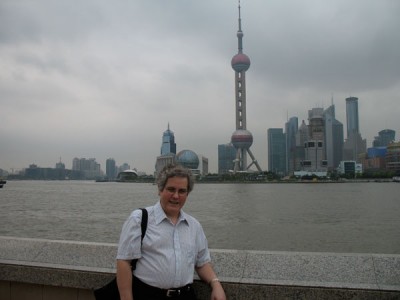
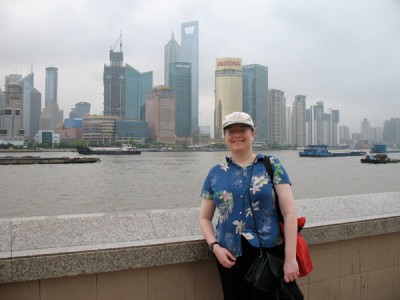
In the other direction, there are the older buildings of the Bund:
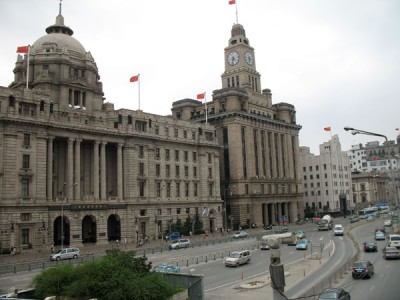 You may have heard that there’s a lot of construction going on in Shanghai and Beijing these days, and you will have heard correctly. Here’s some construction on the Bund to build a pedestrian area. It should be great when it’s done:
You may have heard that there’s a lot of construction going on in Shanghai and Beijing these days, and you will have heard correctly. Here’s some construction on the Bund to build a pedestrian area. It should be great when it’s done:
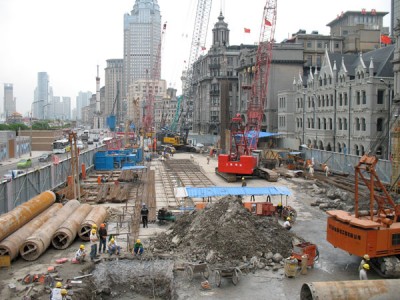 One issue with touring with 300 of your closest friends is that for the big sights, you can’t just pick and choose things based on the weather. Even though one of the themes of the tour was the “changeable plan”, some things would not move in the schedule. So it wound up that we visited the Pearl Radio Tower (the big tower in the first picture) on the rainiest day of our stay in Shanghai. The viewing deck was totally fogged in, but the sign at the entrance attracted interest. Singers are necessarily concerned if they will be considered to be among the “ragamuffin people” denied entry.
One issue with touring with 300 of your closest friends is that for the big sights, you can’t just pick and choose things based on the weather. Even though one of the themes of the tour was the “changeable plan”, some things would not move in the schedule. So it wound up that we visited the Pearl Radio Tower (the big tower in the first picture) on the rainiest day of our stay in Shanghai. The viewing deck was totally fogged in, but the sign at the entrance attracted interest. Singers are necessarily concerned if they will be considered to be among the “ragamuffin people” denied entry.
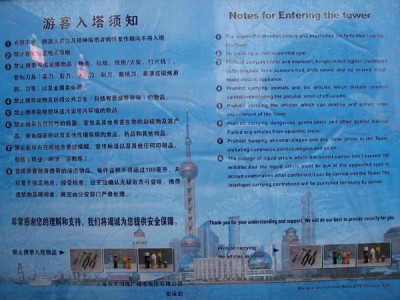 Our two concerts were in the philharmonic orchestra hall at the Shanghai Oriental Arts Center on June 27 and 28. This is a fantastic performance space with outstanding acoustics both on stage and in the audience. It looks like this vineyard style of auditorium is indeed becoming a reliable architectural style for symphony halls that both look and sound good. This hall may not be as live as Walt Disney Hall in Los Angeles. But it is still the best hall I have performed in since moving to California from the Boston area and its great spaces like Symphony Hall and Jordan Hall. Here are some interior shots from a rehearsal with pianist Jon Nakamatsu and conductor Jingdong Cai:
Our two concerts were in the philharmonic orchestra hall at the Shanghai Oriental Arts Center on June 27 and 28. This is a fantastic performance space with outstanding acoustics both on stage and in the audience. It looks like this vineyard style of auditorium is indeed becoming a reliable architectural style for symphony halls that both look and sound good. This hall may not be as live as Walt Disney Hall in Los Angeles. But it is still the best hall I have performed in since moving to California from the Boston area and its great spaces like Symphony Hall and Jordan Hall. Here are some interior shots from a rehearsal with pianist Jon Nakamatsu and conductor Jingdong Cai:
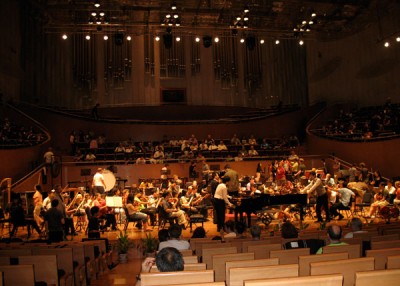
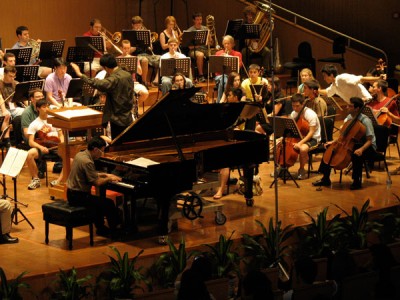 The hall is big so it was hard to get a good exterior shot, but here’s one through the tour bus window:
The hall is big so it was hard to get a good exterior shot, but here’s one through the tour bus window:
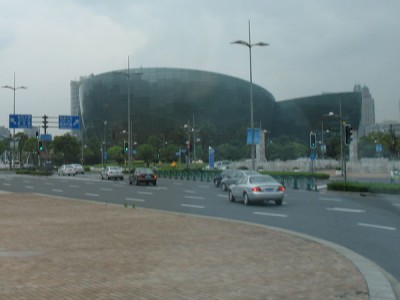 We had two concerts in Shanghai. The first was conducted by Stephen Sano, director of choral studies at Stanford and conductor of the Stanford Symphonic Chorus and Stanford Chamber Chorale, where the chorus sang Carmina Burana. The second was conducted by Jindong Cai, where the chorus sang the finale to Beethoven’s Ninth and a new piece by Zhou Long called Cosmic Flames. Both concerts featured Jon Nakamatsu playing Rhapsody in Blue. They both went well, with the second concert being better-attended. I even got to shake hands with the vice-mayor of Shanghai when she visited backstage at intermission.
We had two concerts in Shanghai. The first was conducted by Stephen Sano, director of choral studies at Stanford and conductor of the Stanford Symphonic Chorus and Stanford Chamber Chorale, where the chorus sang Carmina Burana. The second was conducted by Jindong Cai, where the chorus sang the finale to Beethoven’s Ninth and a new piece by Zhou Long called Cosmic Flames. Both concerts featured Jon Nakamatsu playing Rhapsody in Blue. They both went well, with the second concert being better-attended. I even got to shake hands with the vice-mayor of Shanghai when she visited backstage at intermission.
Our last big sightseeing outing in Shanghai was the Yu Gardens and bazaar. This was our favorite sight in Shanghai but you can see pictures of that everywhere. Since we had over 300 people on this concert tour, a lot of meals were group banquets. But Yu Gardens gave me the opportunity to sample some street food. The supersize XLB were fun:
 But the squid dumplings were even tastier:
But the squid dumplings were even tastier:
 After our last concert it Shanghai, we had a free day until we headed to the Shanghai Railway Station to take the night train to Beijing:
After our last concert it Shanghai, we had a free day until we headed to the Shanghai Railway Station to take the night train to Beijing:

